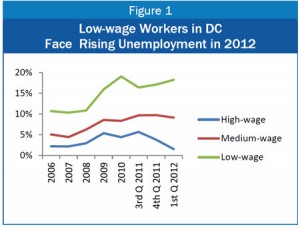On Friday, DC Mayor Vince Gray said unemployment in the District had dropped to 9.5 percent in April, down from 9.8 percent the month prior.
Who are the District’s unemployed residents? Each quarter, DCFPI examines the latest data from the U.S. Census Bureau’s Current Population Survey. For the first quarter of 2012, which covers January through March, unemployment fell for most groups of DC residents, including those with no more than a high school diploma, residents of all races and ethnicities, and for most family types and age groups. Yet there were some notable increases in unemployment for workers in low-wage occupations and for young workers.
To view the full report, click here. Highlights of our findings include:
- Unemployment fell for residents without a college diploma. While residents without a college degree faced substantial increases in unemployment during the recession and are still seeing high unemployment, they saw a decrease in unemployment rates this past quarter. Unemployment among residents with only a high school diploma fell from 25.3 percent in the fourth quarter of 2011 to 19.8 percent in the first quarter of 2012, and for residents with less than a high school diploma, unemployment fell from 24.9 percent to 22.1 percent.

- The unemployment rate for Black residents also fell this past quarter. Black DC residents saw a decrease in unemployment, from 20.4 percent to 18.9 percent. Unemployment for Black residents in the District is still quite high and is currently twice the 2007 rate of 9.4 percent.
- Young workers are seeing a rising unemployment rate. After decreasing in 2011, unemployment among 16 to 24 year-old DC workers jumped from 16.8 percent to 20.5 percent during this period. Young workers continue to experience the highest unemployment rate by age.
- Unemployment among low-wage workers has increased. The unemployment rate for low-wage workers ‘ those in the bottom 25 percent of earners ‘ increased from 17.1 percent in fourth quarter 2011 to 18.2 percent in first quarter 2012. Low-wage workers continue to hold the highest unemployment rate by wage, and the current rate is almost twice as high as the 2006 rate.
The decreases in unemployment among a number of the District’s more vulnerable populations is certainly encouraging, although the data cannot confirm whether these residents are finding jobs or opting to drop out of the workforce. These populations also continue to see unemployment rates that are much higher than pre-recession rates, and it is important to consider policies to support these populations with consistently high unemployment rates.
